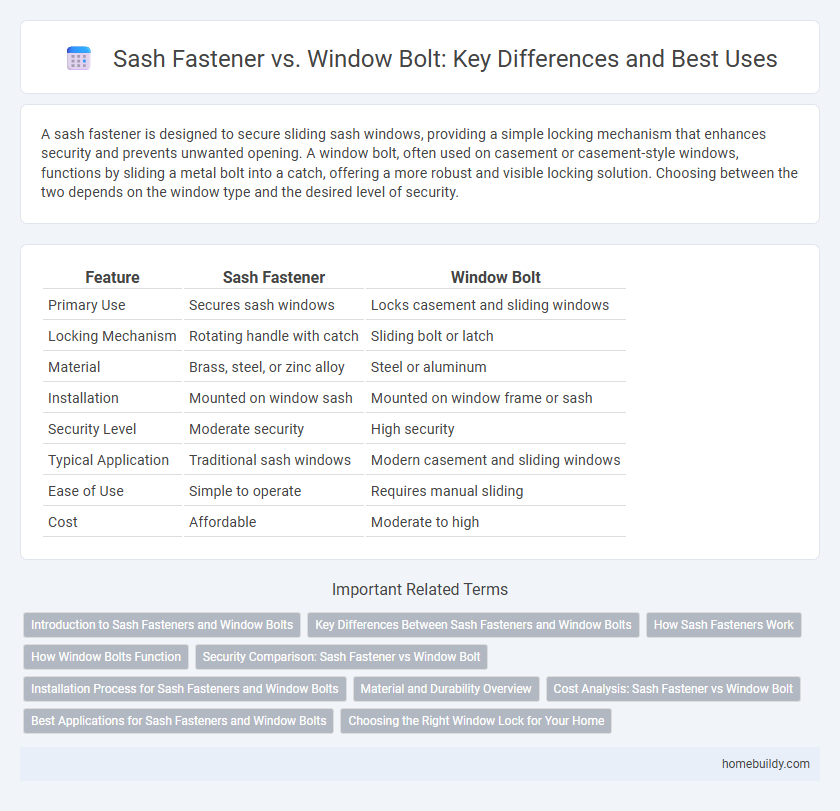A sash fastener is designed to secure sliding sash windows, providing a simple locking mechanism that enhances security and prevents unwanted opening. A window bolt, often used on casement or casement-style windows, functions by sliding a metal bolt into a catch, offering a more robust and visible locking solution. Choosing between the two depends on the window type and the desired level of security.
Table of Comparison
| Feature | Sash Fastener | Window Bolt |
|---|---|---|
| Primary Use | Secures sash windows | Locks casement and sliding windows |
| Locking Mechanism | Rotating handle with catch | Sliding bolt or latch |
| Material | Brass, steel, or zinc alloy | Steel or aluminum |
| Installation | Mounted on window sash | Mounted on window frame or sash |
| Security Level | Moderate security | High security |
| Typical Application | Traditional sash windows | Modern casement and sliding windows |
| Ease of Use | Simple to operate | Requires manual sliding |
| Cost | Affordable | Moderate to high |
Introduction to Sash Fasteners and Window Bolts
Sash fasteners are hardware components designed to secure window sashes, providing both security and a tight seal to improve insulation. Window bolts, in contrast, function as locking mechanisms that slide into place to hold window frames securely. While sash fasteners typically combine aesthetic appeal with functionality, window bolts emphasize strong locking capability for enhanced safety.
Key Differences Between Sash Fasteners and Window Bolts
Sash fasteners primarily secure sash windows by locking the two sashes together, offering enhanced security and ease of operation for traditional wooden windows. Window bolts, on the other hand, provide a more versatile locking mechanism that can be installed on various window types, including casement and sliding windows, offering strong lateral resistance. The key differences lie in their design compatibility, locking method, and typical applications, with sash fasteners favoring aesthetic and functional integration in sash windows while window bolts deliver broader adaptability and robust security.
How Sash Fasteners Work
Sash fasteners operate by securely locking the movable sash of a window against the frame, creating a tight seal that improves insulation and security. Unlike window bolts, which typically use a sliding mechanism to lock the window in place, sash fasteners often use a rotating latch or cam that hooks onto a keeper or strike plate. This action not only enhances the window's stability but also prevents drafts and unauthorized entry by firmly clamping the sash closed.
How Window Bolts Function
Window bolts function by sliding a metal rod into a fixed socket or bracket, securing the window sash firmly in place and preventing it from opening. Unlike sash fasteners, which typically lock the meeting rails of double-hung windows, window bolts provide additional reinforcement by anchoring the window directly to the frame or adjacent surface. This mechanism enhances security and stability, especially for casement or sliding window designs where traditional sash fasteners may not be effective.
Security Comparison: Sash Fastener vs Window Bolt
Sash fasteners provide moderate security by securing sash windows and often include key locking mechanisms to deter forced entry. Window bolts offer enhanced security through robust locking positions that firmly anchor the window frame, making them more resistant to prying and forced opening. For maximum protection, combining sash fasteners with heavy-duty window bolts can significantly improve overall window security against break-ins.
Installation Process for Sash Fasteners and Window Bolts
Sash fasteners typically require precise alignment and often involve screwing directly into the window frame or sash, ensuring a secure fit for traditional wooden or metal casement windows. Window bolts, on the other hand, can be simpler to install, usually involving drilling holes into the window sash and frame before securing the bolt with screws or a locking mechanism. Both installation processes demand accurate measurements and the right tools, but sash fasteners often need more care to maintain the window's aesthetic and historical integrity.
Material and Durability Overview
Sash fasteners are commonly made from high-grade brass or stainless steel, offering excellent resistance to corrosion and wear, which ensures long-lasting performance in various weather conditions. Window bolts often feature galvanized steel or zinc-coated finishes that provide good durability but may be more susceptible to rust over time compared to sash fasteners. The robust materials used in sash fasteners generally result in superior longevity and maintenance-free operation, making them a preferred choice for heritage and high-end window installations.
Cost Analysis: Sash Fastener vs Window Bolt
Sash fasteners generally offer a more cost-effective solution compared to window bolts due to lower material and installation expenses. Window bolts, while providing enhanced security, often involve higher manufacturing costs and complex fitting processes. Choosing sash fasteners can result in significant savings, especially for large-scale residential or commercial projects prioritizing budget efficiency.
Best Applications for Sash Fasteners and Window Bolts
Sash fasteners are best suited for securing traditional timber sash windows, providing a smooth, flush finish ideal for heritage and period properties. Window bolts offer enhanced security and are better for modern or secondary glazing where additional locking points are necessary. Both fasteners complement different window styles, with sash fasteners focusing on aesthetics and ease of operation, while window bolts prioritize robustness and security.
Choosing the Right Window Lock for Your Home
Choosing the right window lock for your home depends on security needs and window type, with sash fasteners offering a traditional, easy-to-use option ideal for double-hung windows. Sash fasteners provide reliable locking by securing the meeting rail, while window bolts offer enhanced stability by immobilizing the window sashes firmly in place. Evaluating durability, installation ease, and aesthetic compatibility helps homeowners select between sash fasteners and window bolts for optimal protection and functionality.
Sash fastener vs Window bolt Infographic

 homebuildy.com
homebuildy.com